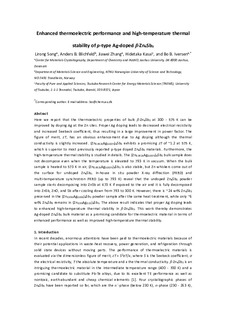Enhanced thermoelectric performance and high-temperature thermal stability of p-type Ag-doped β-Zn4Sb3
Journal article
Submitted version
Permanent lenke
http://hdl.handle.net/11250/2563766Utgivelsesdato
2018Metadata
Vis full innførselSamlinger
- Institutt for materialteknologi [2549]
- Publikasjoner fra CRIStin - NTNU [38127]
Sammendrag
Here we report that the thermoelectric properties of bulk β-Zn4Sb3 can be improved in the range 300–575 K by Ag doping at the Zn sites. Proper Ag doping leads to decreased electrical resistivity and increased Seebeck coefficient, thus resulting in a large improvement in power factor. The figure of merit, zT, has an obvious enhancement due to Ag doping although the thermal conductivity is slightly increased. (Zn0.9925Ag0.0075)4Sb3 exhibits a promising zT of ∼1.2 at 575 K, which is superior to most previously reported p-type doped Zn4Sb3 materials. Furthermore, the high-temperature thermal stability is studied in detail. The (Zn0.9925Ag0.0075)4Sb3 bulk sample does not decompose even when the temperature is elevated to 793 K in vacuum. When the bulk sample is heated to 573 K in air, (Zn0.9925Ag0.0075)4Sb3 is also stable, unlike undoped Zn4Sb3 where Zn whiskers come out of the surface. In-house in situ powder X-ray diffraction (PXRD) and multi-temperature synchrotron PXRD (up to 793 K) reveal that the undoped Zn4Sb3 powder sample starts decomposing into ZnSb at 473 K if exposed to the air and it is fully decomposed into ZnSb, ZnO, and Sb after cooling down from 793 to 300 K. However, there is ∼24 wt% Zn4Sb3 preserved in the (Zn0.995Ag0.005)4Sb3 powder sample after the same heat treatment, while only ∼6 wt% Zn4Sb3 remains in (Zn0.99Ag0.01)4Sb3. The above result indicates that proper Ag doping leads to enhanced high-temperature thermal stability in β-Zn4Sb3. This work thereby suggests Ag-doped Zn4Sb3 bulk material as a promising candidate for thermoelectric applications in terms of enhanced performance as well as improved high-temperature thermal stability.
